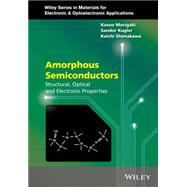Amorphous semiconductors are subtances in the amorphous solid state that have the properties of a semiconductor and which are either covalent or tetrahedrally bonded amorphous semiconductors or chelcogenide glasses.
- Developed from both a theoretical and experimental viewpoint
- Deals with, amongst others, preparation techniques, structural, optical and electronic properties, and light induced phenomena
- Explores different types of amorphous semiconductors including amorphous silicon, amorphous semiconducting oxides and chalcogenide glasses
- Applications include solar cells, thin film transistors, sensors, optical memory devices and flat screen devices including televisions








